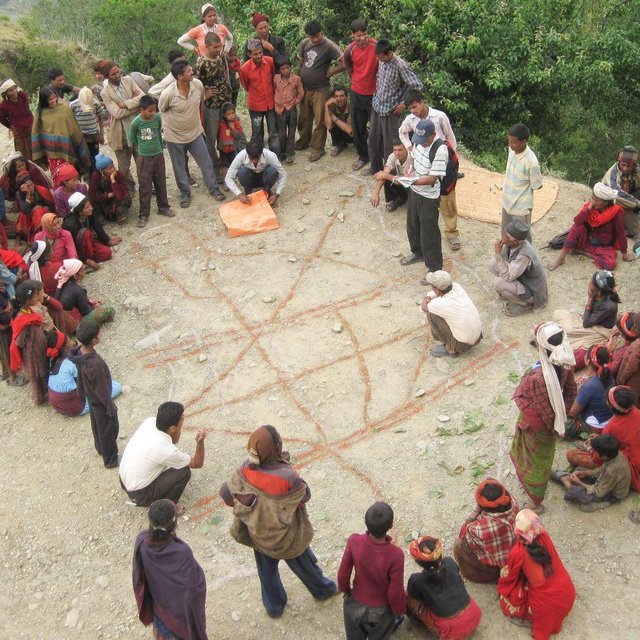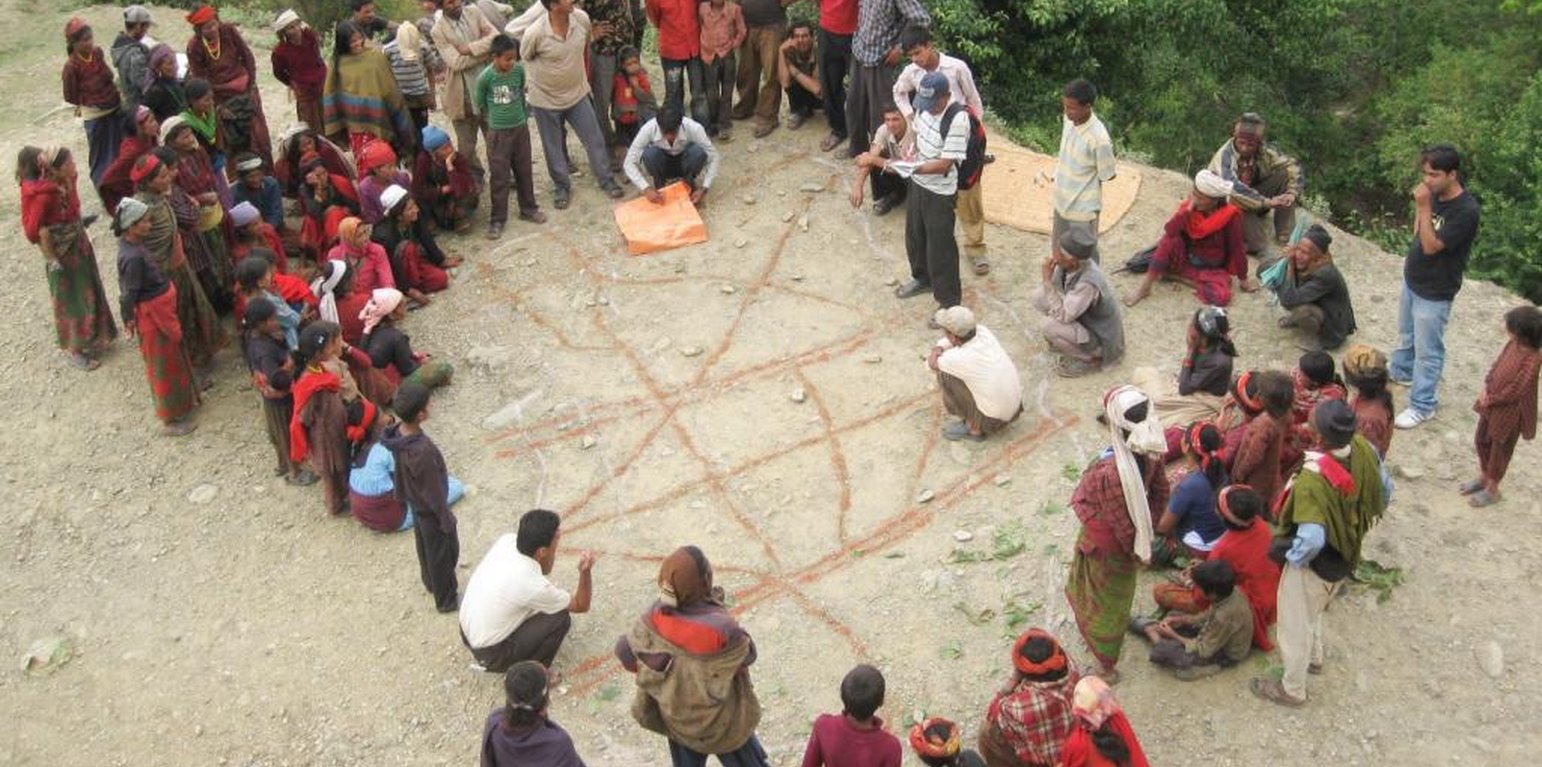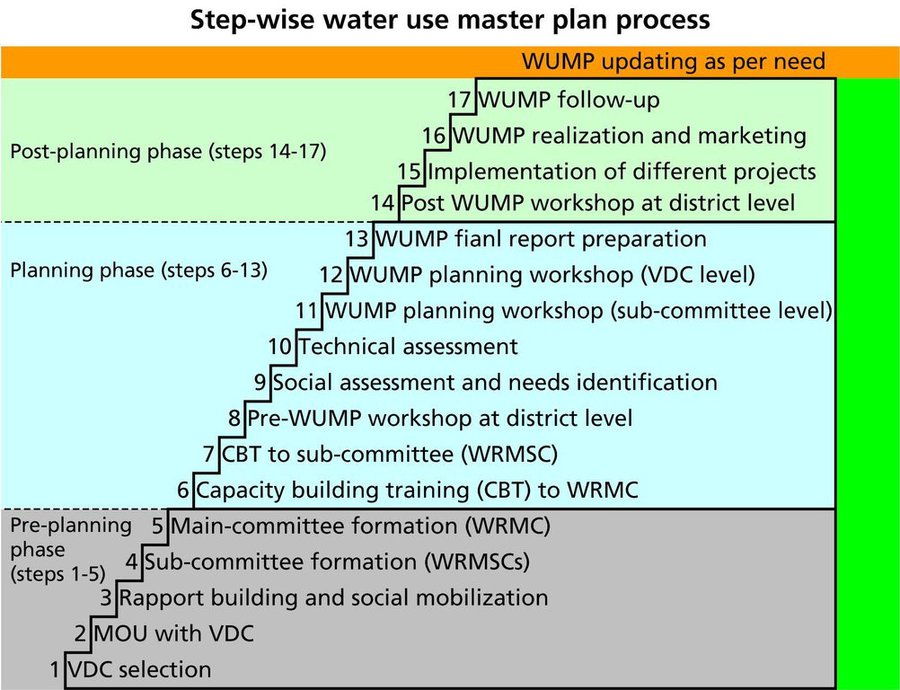Water use master plan
(尼泊尔)
Jal upoyog guru yogana (Main Contributor: HELVETAS Nepal)
描述
A water use master plan supports the development of integrated water resources at the local level; all stakeholders, including disadvantaged groups, take part in the plan.
Aims / objectives: A water use master plan (WUMP) is a holistic, participatory, and inclusive planning process that takes an integrated approach to the management of water resources and uses at the village level. The WUMP specifies the total water budget for its planning unit, the village development committee (VDC), and explores potential uses for it. It empowers marginalized groups to claim their rights to an equitable share of water within and between communities. The WUMP also helps local bodies with annual and periodic planning and project prioritization.
Methods: The WUMP is a 17-step process that includes social mobilization, the formation of inclusive management committees, capacity building for everyone involved in the process, and, as a final step, social assessment using various participatory rural appraisal (PRA) tools. Simultaneously, the technical part of the process evaluates the capacity of all water resources and their potential uses. In a workshop facilitated by NGO staff, the community discusses suggestions formulated by the two participatory assessments, prioritizes possible projects, and formulates plans. The VDC representatives decide which plans can be implemented using their own resources and which need external support. The WUMP then organizes a workshop to present these plans to various organizations in order to get their commitment and support. The prioritized projects are implemented according to the WUMP.
The plan also contains a series of long-term activities and during the course of its implementation, there is sufficient latitude to allow the community to rectify its original plans in order to put into practise lessons learned during earlier phases and to continue to review and modify the plan as needed.
地点
![]()
地点: 15 districts in the Western, Mid-Western, and Far-Western Development Regions of Nepal, 尼泊尔
启动日期: 不适用
终止年份: 不适用
方法的类型

A community gathers for social and resource mapping; a facilitator talks them through the mapping exercise. (WARM-P)

Household rainwater harvesting tanks in Dailekh. (WARM-P)
方法目标和有利环境
该方法的主要目的/目标
The Approach focused mainly on SLM with other activities (Water conservation, water sources and catchment area)
• Establish inclusive water planning and water resource management at the community level
• Ensure the optimal use of water resources; see that water is equitably and efficiently distributed
• Promote conservation of water and natural resources linked to water; implement water projects based on the plan agreed by the entire community
The SLM Approach addressed the following problems: • Issues on access to water are often contentious, communities often quarrel over water rights
• A lack of coordinated planning at the local level
• A growing demand for water both for domestic and agricultural use
• Water sources are diminishing and the changing climate will further aggravate this
推动实施本办法所应用技术的条件
-
法律框架(土地使用权、土地和水使用权): Ensuring equitable use of water resources is a key feature of the WUMP approach.
阻碍实施本办法所应用技术的条件
-
社会/文化/宗教规范和价值观: Communities are reluctant to share water resources and
hide the sources of water during planning
Treatment through the SLM Approach: Earn everyone's trust through meetings, dialogue, and social mapping that includes all stakeholders including disadvantaged groups.
-
财务资源和服务的可用性/可得性: When the WUMP is implemented by the VDC using its
own funds it usually takes a long time.
Treatment through the SLM Approach: Collaborate and network with resource organizations such as INGOs and donor funded programmes for funding.
-
机构设置: There is no elected body in the VDC and no one takes permanent ownership of the WUMP.
Treatment through the SLM Approach: Create an advisory body consisting of representatives from all political parties.
-
了解SLM,获得技术支持: When the administrative boundaries of a VDC do not coincide with its physical watershed boundaries, it can be difficult to make technical decisions.
Treatment through the SLM Approach: Cluster VDCs into groups in the same sub/watershed.
-
其他: Low awareness of the need for conservation and of the
need to use water efficiently
Treatment through the SLM Approach: Intensive awareness raising and capacity building programmes
相关利益相关者的参与和角色
该方法涉及的利益相关者及其职责
| 该方法涉及哪些利益相关者/执行机构? |
指定利益相关者 |
说明利益相关者的角色 |
| 当地土地使用者/当地社区 |
VDC |
Equal participation of men and women is encouraged during the social assessment and needs identification phase. During the planning and implementation phases, the participation of women in decision making is ensured through a provision that there be a representation of at least 33% women in the water resource management committees, sub-committees, and users' committees. Disadvantaged groups (Dalit and Janajati among others) are requested to participate in numbers proportional to the percentage they represent in the community in all activities and committees. |
| 教师/学龄儿童/学生 |
|
|
| NGO |
HELVETAS |
|
| 国家政府(规划者、决策者) |
|
|
当地土地使用者/当地社区参与该方法的不同阶段
启动/动机
Community meetings, decision taken by the VDC on how to prepare the WUMP
计划
Social and resource mapping, social assessments, technical assessments and planning
实施
Implementation of the water projects, source protection/conservation
监测/评估
Review of the plan, community monitoring during the construction phase, follow-up monitoring during routine operation
流程图
The step-wise WUMP process
VDC = Village development committee
MOU = Memorandum of understanding
WRMC = Water resource management committee
WRMSC = Water resource management sub-committee
WUMP = Water use master plan
(AK Thaku)
有关SLM技术选择的决策
决策是由......做出的
-
仅限土地使用者(自主)
-
主要是土地使用者,由SLM专家提供支持
-
所有相关参与者,作为参与式方法的一部分
-
主要是SLM专家,咨询土地使用者之后
-
仅限SLM专家
-
政治家和领袖
决策是基于
-
对充分记录的SLM知识进行评估(基于证据的决策)
-
研究结果
-
个人经验和意见(无记录)
技术支持、能力建设和知识管理
以下活动或服务是该方法的一部分
-
能力建设/培训
-
咨询服务
-
机构强化(组织发展)
-
监测和评估
-
研究
能力建设/培训
向以下利益相关者提供培训
-
土地使用者
-
现场工作人员/顾问
-
Local Community
涵盖的主题
• Social mobilization and awareness raising orientations, training
• Capacity building and training to WRMC and local service providers
机构强化
进一步细节
Support is provided to the VDC for the preparation of the WUMP
监测和评估
bio-physical aspects were monitored through measurements; indicators: Follow-up monitoring to check if the water sources are protected, and if the area is conserved by planting
technical aspects were monitored through measurements; indicators: Follow-up monitoring to check water sources and number of water projects implemented
socio-cultural aspects were monitored through measurements; indicators: Public hearings and audits to ensure transparency and community participation (especially of disadvantaged groups)
area treated aspects were monitored through measurements; indicators: Follow-up monitoring of implementation (as shown in the diagram )
no. of land users involved aspects were monitored through measurements; indicators: Public review, final commissioning: community contribution and participation (as shown in the diagram)
management of Approach aspects were monitored through measurements; indicators: WUMP follow-up: implementation of WUMP (as shown in the diagram )
Implementation of WUMP aspects were monitored through measurements; indicators: WUMP follow-up: implementation of WUMP (as shown in the diagram )
There were few changes in the Approach as a result of monitoring and evaluation: • All members of the community, even those with water resources on their own land, are willing to share water resources after participating in the WUMP.
• Disadvantaged groups participate on an equal footing in management committees and have equal access to water resources.
• The community realizes the need to protect water resources and begins to conserve water.
融资和外部物质支持
SLM组成部分的年度预算,以美元计算
-
< 2,000
-
2,000-10,000
-
10,000-100,000
-
100,000-1,000,000
-
> 1,000,000
Precise annual budget: 不适用
Approach costs were met by the following donors: national non-government: 75.0%; local community / land user(s): 25.0%
已向土地使用者提供以下服务或激励
-
为土地使用者提供财政/物质支援
-
特定投入的补贴
-
信用
-
其它激励或手段
影响分析和结论性陈述
方法的影响
该方法是否帮助土地使用者实施和维护SLM技术?
Water, forests, and land are all interlinked. Proper management of water resources, source protection, and conservation are all part of sustainable land management.
该方法是否有助于社会和经济弱势群体?
Disadvantaged groups participate and share benefits on equal terms.
Did other land users / projects adopt the Approach?
This approach has been replicated by the Rural Water Resources Management Project of FINNIDA, the LIVE/EU project, and Nepal Water for Health (NEWAH), a national-level NGO in Nepal. Nepal's Ministry of Local Development, Department of Local Infrastructure and Roads, has expressed an interest in developing WUMPs for all the VDCs in Nepal.
土地使用者实施SLM的主要动机
-
Equitable and sustainable access to water resource
方法活动的可持续性
土地使用者能否维持通过该方法实施的措施(无外部支持的情况下)?
结论和吸取的教训
长处: 土地使用者的观点
长处: 编制者或其他关键资源人员的观点
-
Communities appreciate the WUMP approach (How to sustain/ enhance this strength: The Ministry of Local Development has expressed an interest in preparing national guidelines for this process in order to scale it up to all the VDCs in Nepal)
-
VDCs own the process both by participating and by contributing to the funding. (How to sustain/ enhance this strength: Need to simplify the process and make it more cost effective so that it is easier to replicate.)
-
An integrated approach to the use of water resources may help in climate change adaptation. (How to sustain/ enhance this strength: Strengthen awareness activities and continue to promote water conservation)
-
The WUMP process is inclusive and is managed by the whole community.
(How to sustain/ enhance this strength: Continue to strengthen the capacity of disadvantaged groups so that they can participate more actively.)
弱点/缺点/风险: 土地使用者的观点如何克服
弱点/缺点/风险: 编制者或其他关键资源人员的观点如何克服
-
Not all VDCs actively participate in the WUMP
When VDCs contribute funds for the WUMP, they are usually more actively involved.
-
Communities can have high expectations for WUMP but their VDCs may have limited resources.
The VDCs need to communicate clearly with their community so that they can prepare a realistic plan together.
-
Conflicts can arise over the allocation of water resources
The VDC and the management committee must work with the community to see that any contentious issues are resolved equitably
-
At times it can be difficult to get everyone to agree to a given
WUMP.
The VDC authorities can improve their negotiating skills in order to make their demands heard with donors and district development committees.
参考文献
实施日期: Aug. 25, 2015
上次更新: July 7, 2017
资源人
-
Shreedip Sigdel (shreedip.sigdel@icimod.org) - SLM专业人员
-
Merz Jürg (juerg.merz@helvetas.org.np) - SLM专业人员
文件编制者
机构
- HELVETAS (Swiss Intercooperation)
- ICIMOD International Centre for Integrated Mountain Development (ICIMOD) - 尼泊尔
项目
主要参考文献
-
Water use master plan preparation guideline. Lalitpur, Nepal: WARM-P/HELVETAS; Rural Village Water Resource Management Project (2011) Proceedings of water use master plan national level experience sharing workshop. Lalitpur, Nepal, HELVETAS (2007):






